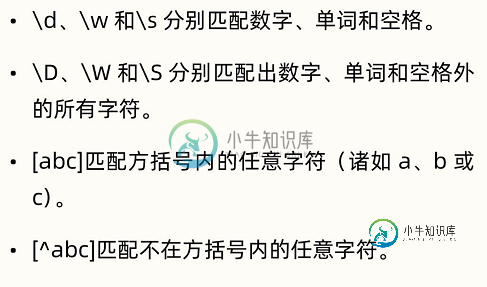Python正则re模块使用步骤及原理解析
python中使用正则表达式的步骤:
1.导入re模块:import re
2.初始化一个Regex对象:re.compile()
3.刚刚创建的Regex对象调用search方法进行匹配,返回要给March对象
4.刚刚的March对象调用group方法,展示匹配到的字符串
下面例子的知识点:
对正则表达式分组用:(),正则里的分组计数从1开始,不是从0,切记~~
- group(数字):去对应的分组的值
- groups():返回所有分组的元组形式
\d表示一个数字
regex_obj = re.compile(r'(\d\d\d)-(\d\d\d)-(\d\d\d\d)')
match_obj = regex_obj.search('我司电话:035-411-1234')
result1 = match_obj.group(1)
result2 = match_obj.group(2)
result3 = match_obj.group(3)
print(result1)
print(result2)
print(result3)
result4 = match_obj.group()
print(result4)
result5 = match_obj.groups()
print(result5)
执行结果:
035
411
1234
035-411-1234
('035', '411', '1234')
补充知识点:\w表示一个单词,\s表示一个空格
regex_obj = re.compile(r'(\d\w\d)-(\d\d\d)-(\d\d\d\d)')
match_obj = regex_obj.search('我司电话:0a5-411-1234')
result = match_obj.group(1)
print(result)
regex_obj = re.compile(r'(\d\w\d)-(\d\d\d)-(\d\d\d\d)')
match_obj = regex_obj.search('我司电话:0哈5-411-1234')
result = match_obj.group(1)
print(result)
regex_obj = re.compile(r'(\d\s\d)-(\d\d\d)-(\d\d\d\d)')
match_obj = regex_obj.search('我司电话:0 5-411-1234')
result = match_obj.group(1)
print(result)
执行结果:
0a5
0哈5
0 5
| 或:
regex_obj = re.compile(r'200|ok|successfully')
match_obj1 = regex_obj.search('vom get request and stored successfully')
result1 = match_obj1.group()
print(result1)
match_obj2 = regex_obj.search('vom get request,response 200 ok')
result2 = match_obj2.group()
print(result2)
match_obj3 = regex_obj.search('vom get request,response ok 200')
result3 = match_obj3.group()
print(result3)
执行结果:
successfully
200
ok
注意:如果search返回的March对象只有一个结果值的话,不能用groups,只能用group
regex_obj = re.compile(r'200|ok|successfully')
match_obj1 = regex_obj.search('vom get request and stored successfully')
result2 = match_obj1.groups()
print(result2)
result1 = match_obj1.group()
print(result1)
执行结果:
()
successfully
? :可选匹配项
+ :1次 或 n次 匹配
* :*前面的字符或者字符串匹配 0次、n次
注意:*前面必须要有内容
regex_obj = re.compile(r'(haha)*,welcome to vom_admin system') 指haha这个字符串匹配0次或者多次
regex_obj = re.compile(r'(ha*),welcome to vom_admin system') 指ha这个字符串匹配0次或者多次
. : 通配符,匹配任意一个字符
所以常常用的组合是:.*
regex_obj = re.compile(r'(.*),welcome to vom_admin system')
match_obj1 = regex_obj.search('Peter,welcome to vom_admin system')
name = match_obj1.group(1)
print(name)
执行结果:
Peter
{} : 匹配特定的次数
里面只写一个数字:匹配等于数字的次数
里面写{3,5}这样两个数字的,匹配3次 或 4次 或 5次,按贪心匹配法,能满足5次的就输出5次的,没有5次就4次,4次也没有才是3次
regex_obj = re.compile(r'((ha){3}),this is very funny')
match_obj1 = regex_obj.search('hahahaha,this is very funny')
print("{3}结果",match_obj1.group(1))
regex_obj = re.compile(r'((ha){3,5}),this is very funny')
match_obj1 = regex_obj.search('hahahaha,this is very funny')
print("{3,5}结果",match_obj1.group(1))
执行结果:
{3}结果 hahaha
{3,5}结果 hahahaha
findall():返回所有匹配到的字串的列表
regex_obj = re.compile(r'\d\d\d')
match_obj = regex_obj.findall('我是101班的,小李是103班的')
print(match_obj)
regex_obj = re.compile(r'(\d\d\d)-(\d\d\d)-(\d\d\d\d)')
match_obj = regex_obj.findall('我家电话是123-123-1234,我公司电话是890-890-7890')
print(match_obj)
打印结果:
['101', '103']
[('123', '123', '1234'), ('890', '890', '7890')]
[]:创建自己的字符集:
[abc]:包括[]内的字符
[^abc]:不包括[]内的所有字符
也可以使用:[a-zA-Z0-9]这样简写
regex_obj = re.compile(r'[!@#$%^&*()]')
name = input("请输入昵称,不含特殊字符:")
match_obj = regex_obj.search(name)
if match_obj:
print("昵称输入不合法,包含了特殊字符:", match_obj.group())
else:
print("昵称有效")
执行结果:
请输入昵称,不含特殊字符:*h
昵称输入不合法,包含了特殊字符: *
^:开头
$:结尾
regex_obj = re.compile(r'(^[A-Z])(.*)')
name = input("请输入昵称,开头必须大写字母:")
match_obj = regex_obj.search(name)
print(match_obj.group())
执行结果:
请输入昵称,开头必须大写字母:A1234
A1234
sub():第一个参数为要替换成的,第二个参数传被替换的,返回替换成功后的字符串
regex_obj = re.compile(r'[!@#$%^&*()]')
match_obj = regex_obj.sub('嘿','haha,$%^,hahah')
print(match_obj)
执行结果:
haha,嘿嘿嘿,hahah
补充一下正则表达式的表,正则太复杂了,要常看常用才能熟练


以上就是本文的全部内容,希望对大家的学习有所帮助,也希望大家多多支持小牛知识库。
-
本文向大家介绍详解Python正则表达式re模块,包括了详解Python正则表达式re模块的使用技巧和注意事项,需要的朋友参考一下 正则是处理字符串最常用的方法,我们编码中到处可见正则的身影。 正则大同小异,python 中的正则跟其他语言相比略有差异: 1、替换字符串时,替换的字符串可以是一个函数 2、split 函数可以指定分割次数,这会导致有个坑 3、前项界定的表达式必须定长 下面详细描述下
-
本文向大家介绍正则表达式+Python re模块详解,包括了正则表达式+Python re模块详解的使用技巧和注意事项,需要的朋友参考一下 正则表达式(Regluar Expressions)又称规则表达式,在代码中常简写为REs,regexes或regexp(regex patterns)。它本质上是一个小巧的、高度专用的编程语言。 通过正则表达式可以对指定的文本实现 匹配测试、内容查找、内容
-
本文向大家介绍python正则表达式re模块详解,包括了python正则表达式re模块详解的使用技巧和注意事项,需要的朋友参考一下 快速入门 执行结果: 执行结果: 执行结果: 执行结果:
-
本文向大家介绍python re模块和正则表达式,包括了python re模块和正则表达式的使用技巧和注意事项,需要的朋友参考一下 一、re模块和正则表达式 先来看一个例子:https://reg.jd.com/reg/person?ReturnUrl=https%3A//www.jd.com/ 这是京东的注册页面,打开页面我们就看到这些要求输入个人信息的提示。假如我们随意的在手机号码这一栏输入一
-
本文向大家介绍python re正则表达式模块(Regular Expression),包括了python re正则表达式模块(Regular Expression)的使用技巧和注意事项,需要的朋友参考一下 模块的的作用主要是用于字符串和文本处理,查找,搜索,替换等 复习一下基本的正则表达式吧 .:匹配除了换行符以为的任意单个字符 *:匹配任意字符,一个,零个,多个都能匹配得到 俗称贪婪模式
-
在 Python 中,我们可以使用内置的 re 模块来使用正则表达式。 有一点需要特别注意的是,正则表达式使用 对特殊字符进行转义,比如,为了匹配字符串 ‘python.org’,我们需要使用正则表达式 'python.org',而 Python 的字符串本身也用 转义,所以上面的正则表达式在 Python 中应该写成 'python\.org',这会很容易陷入 的困扰中,因此,我们建议使用 Py

